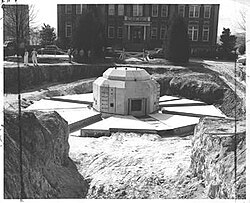North Carolina State University reactor program
| Pulstar | |
|---|---|

Picture of R-1 reactor while under construction
|
|
| Operating Institution | North Carolina State University |
| Location | Raleigh, North Carolina |
| Type | pool |
| Power | 1 MW (thermal) |
| Construction and Upkeep | |
| Construction Cost | $1.5 million USD |
| Construction Began | June 1, 1969 |
| First Criticality | January 1, 1972 |
| Staff | 7 |
| Operators | 3 |
| Technical Specifications | |
| Max Thermal Flux | 1.1e13 n/cm^2-s |
| Fuel Type | U02 pellets, pin lattice |
| Cooling | n/cm^2-s |
| Neutron Moderator | light water |
| Neutron Reflector | graphite, beryllium |
| Control Rods | 4 Rods |
| Cladding Material | Zirconium Alloy |
| Source(s): IAEA Database of Reactors data from 2002-09-04 | |
North Carolina State University in 1950 founded the first university-based reactor program and Nuclear Engineering curriculum in the United States. The program continues in the early 21st century. That year, NC State College administrators approved construction of a reactor and the establishment of a collegiate nuclear engineering program. The first research reactor was completed in 1953; it was scaled up in 1957 and 1960 (referred to as R-1, R-2, and R-3). It was deactivated in 1973 to make way for the PULSTAR reactor. The old reactor has been decommissioned.
The PULSTAR is used for a variety of purposes, including training and research. The reactor is located in Burlington Engineering laboratories on NCSU's main campus. This facility was built to house the first reactor and then expanded and renamed when the PULSTAR was built. The current reactor is one of two PULSTAR reactors built, and the only one still in operation. The other reactor was a 2 MW reactor at the State University of New York at Buffalo. It went critical in 1964 and was decommissioned in 1994.
The PULSTAR reactor is situated along Engineering Row in the main campus, surrounded by Mann Hall, Daniels, Polk Hall, and a park. The reactor has a dedicated building and uses one cooling tower; it releases water vapor when the reactor is at high power. This building is not a Containment building, but it maintains a negative pressure to prevent any release of radioactive material. The reactor can be operated up to a power of 100 kW on natural circulation, or 1 Megawatt (MW) with the use of pumps.
The reactor enriches the department curricula by providing hands on experience as well as training for students. In 2002, department enrollment was 72 total undergraduate students, 15 masters students, and 22 PhD students, all of whom use the reactor. Additionally, 34 researches outside of Nuclear Engineering use the reactor and associated facilities.
...
Wikipedia
